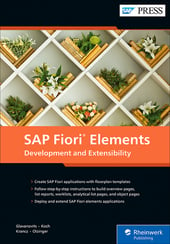The SAP Fiori elements framework allows developers to build SAP Fiori frontends with minimal code – unlike freestyle applications, which require extensive coding to program the interface.
SAP Fiori elements provides a set of templates, or floorplans, to accelerate application development and ensure a consistent look and feel. The framework provides the following floorplans: list report, worklist, object page, overview page, and analytic list page.
Let’s take a look at the concept of low-code development and how it’s incorporated into SAP Fiori elements.
Low-Code Development
Low-code tools enable developers to create apps quickly and with a minimal amount of manual programming. This is not to be confused with no-code tools, which are aimed toward users who are unfamiliar with any programming languages but still want to develop an app for a specific use case.
Traditional low-code platforms offer visual modeling tools, prebuilt modules, cross-platform support, application lifestyle management, and reporting and monitoring. They rely on established user interface (UI) frameworks such as Angular.js, Vue.js, or React.
SAP Fiori elements is a UI development library based on the SAPUI5 framework. The UIs are generated from metadata at runtime, which results in low development effort for standard use cases. However, SAP Fiori elements is not considered a typical low-code development because the properties of low-code platforms aren’t included.
SAP Fiori elements doesn’t use the typical approach of prebuilt modules and visual modeling tools. It goes a step further with additional annotations and controls – not only individual, loose controls, but entire views in the form of floorplans. SAP Fiori elements works with UI annotations that influence the behavior and appearance of SAP Fiori apps in the form of metadata. For example, annotations can influence smart controls such as smart tables or smart forms in classic SAP Fiori apps. This means SAP has enabled developers to control the behavior of apps from the backend. Changes to metadata in the backend immediately affect the UI, without the need to recreate or regenerate the UI. Therefore, to work with SAP Fiori elements, you should have basic programming skills or knowledge of the supported UI annotations.
About the SAP Fiori Elements: Development and Extensibility Book
Ready to take the pain out of SAP Fiori application coding? Our SAP Fiori Elements: Development and Extensibility book will show you how to optimize development with low-code floorplans.
The book begins with the basics of SAP Fiori elements and describes how the framework fits into the trends of low-code and no-code development. You’ll become familiar with the necessary concepts for developing applications, review different types of programming models, and discover development tools that SAP supports for SAP Fiori elements, including both cloud and on-premise tools.
Once you’ve gained an understanding of the underlying tools and technologies, you’ll be ready to dive into development. Get to know the five floorplans and learn how to develop SAP Fiori applications using each one.
Next, the book discusses different deployment options and will show you how to configure the SAP Fiori launchpad for central access to SAP Fiori elements applications. SAP also offers an enhancement concept for SAP Fiori elements for those who don’t stay within standard deployment. You’ll learn more about this option and explore examples of frequently-required enhancement options for individual floorplans.
We close out the book with an understanding of app-to-app navigation. This chapter will show you how to call external URLs. You’ll also find clear summaries of the annotations used in the examples throughout the book.
Who Is This Book For?
This book is useful to SAP developers of all backgrounds looking to learn how to use the SAP Fiori elements framework. It will benefit those with minimal web development skills, since extensive knowledge is not required.
About the Authors
Rene Glavanovits is an SAP consultant and developer at CloudDNA GmbH, an SAP partner in Austria. He specializes in the latest SAP technologies, specifically in the development of full-stack applications with SAP Fiori, SAPUI5, OData, core data services (CDS), and SAP Cloud Application Programming Model.
Martin Koch is the managing director of CloudDNA GmbH, an SAP partner in Austria. His focus is on SAP Business Technology Platform (SAP BTP), user experience, integration, and security. In addition to his SAP-related work, he is an active champagne importer and dealer in Austria.
Daniel Krancz is a software developer and consultant at CloudDNA GmbH. His focus is full-stack development with SAPUI5/SAP Fiori, OData, SAP Cloud Application Programming Model, and ABAP RESTful application programming model, as well as mobile development. He has been teaching SAP trainings since 2019 and has been named a certified trainer and consultant for his achievements by SAP.
Maximilian Olzinger is a software developer and consultant at CloudDNA GmbH. He is an SAP Certified Development Associate and has handled projects for companies in all industries with great success. He conducts trainings in the areas of SAP Fiori, ABAP, and web development. He has developed several SAP standard trainings for SAP Fiori.
How to Purchase
If you’re interested in purchasing the SAP Fiori Elements: Development and Extensibility book, follow this link and choose the format that works best for you: e-book, print edition, or bundle (both e-book and print).
If you want to continue learning about SAP Fiori, or if you want information on other upcoming books or special offers, make sure to sign up for our topic newsletters or our weekly blog recap.



Comments